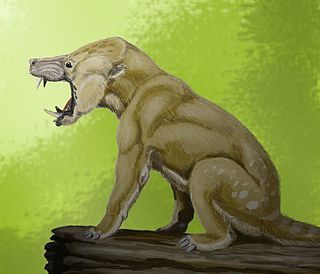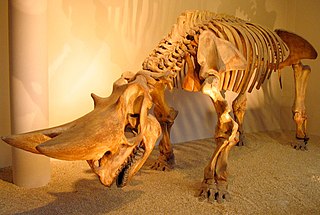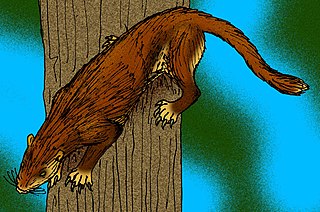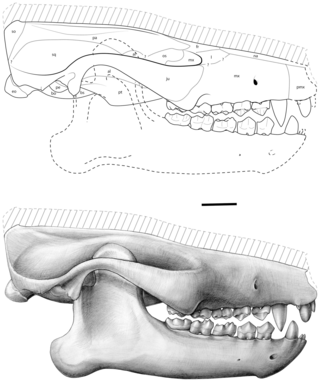
Perissodactyla is an order of ungulates. The order includes about 17 living species divided into three families: Equidae, Rhinocerotidae (rhinoceroses), and Tapiridae (tapirs). They typically have reduced the weight-bearing toes to three or one of the five original toes, though tapirs retain four toes on their front feet. The nonweight-bearing toes are either present, absent, vestigial, or positioned posteriorly. By contrast, artiodactyls bear most of their weight equally on four or two of the five toes: their third and fourth toes. Another difference between the two is that odd-toed ungulates digest plant cellulose in their intestines, rather than in one or more stomach chambers as even-toed ungulates, with the exception of Suina, do.

Ungulates are members of the diverse clade Euungulata which primarily consists of large mammals with hooves. Once part of the clade "Ungulata" along with the clade Paenungulata, "Ungulata" has since been determined to be a polyphyletic and thereby invalid clade based on molecular data. As a result, true ungulates had since been reclassified to the newer clade Euungulata in 2001 within the clade Laurasiatheria while Paenungulata has been reclassified to a distant clade Afrotheria. Living ungulates are divided into two orders: Perissodactyla including equines, rhinoceroses, and tapirs; and Artiodactyla including cattle, antelope, pigs, giraffes, camels, sheep, deer, and hippopotamuses, among others. Cetaceans such as whales, dolphins, and porpoises are also classified as artiodactyls, although they do not have hooves. Most terrestrial ungulates use the hoofed tips of their toes to support their body weight while standing or moving. Two other orders of ungulates, Notoungulata and Litopterna, both native to South America, became extinct at the end of the Pleistocene, around 12,000 years ago.

Afrotheria is a clade of mammals, the living members of which belong to groups that are either currently living in Africa or of African origin: golden moles, elephant shrews, otter shrews, tenrecs, aardvarks, hyraxes, elephants, sea cows, and several extinct clades. Most groups of afrotheres share little or no superficial resemblance, and their similarities have only become known in recent times because of genetics and molecular studies. Many afrothere groups are found mostly or exclusively in Africa, reflecting the fact that Africa was an island continent from the Cretaceous until the early Miocene around 20 million years ago, when Afro-Arabia collided with Eurasia.

Condylarthra is an informal group – previously considered an order – of extinct placental mammals, known primarily from the Paleocene and Eocene epochs. They are considered early, primitive ungulates. It is now largely considered to be a wastebasket taxon, having served as a dumping ground for classifying ungulates which had not been clearly established as part of either Perissodactyla or Artiodactyla, being composed thus of several unrelated lineages.

Embrithopoda ("heavy-footed") is an order of extinct mammals known from Asia, Africa and Eastern Europe. Most of the embrithopod genera are known exclusively from jaws and teeth dated from the late Paleocene to the late Eocene; however, the order is best known from its terminal member, the elephantine Arsinoitherium.
The Thanetian is, in the ICS Geologic timescale, the latest age or uppermost stratigraphic stage of the Paleocene Epoch or Series. It spans the time between 59.2 and56 Ma. The Thanetian is preceded by the Selandian Age and followed by the Ypresian Age. The Thanetian is sometimes referred to as the Late Paleocene.

South American native ungulates, commonly abbreviated as SANUs, are extinct ungulate-like mammals of controversial affinities that were indigenous to South America prior to the Great American Biotic Interchange. They comprise five major groups conventionally ranked as orders—Astrapotheria, Litopterna, Notoungulata, Pyrotheria, and Xenungulata—as well as the primitive "condylarth" groups Didolodontidae and Kollpaniinae. It has been proposed that some or all of the members of this group form a clade, named Meridiungulata, though the relationships of South American ungulates remain largely unresolved. The two largest groups of South American ungulates, the notoungulates and the litopterns, were the only groups to persist beyond the mid Miocene. Only a few of the largest species of notoungulates and litopterns survived until the end-Pleistocene extinction event around 12,000 years ago where they became extinct with most other large mammals in the Americas, shortly after the first arrival of humans into the region.
Numidotheriidae is an extinct family of primitive proboscideans that lived from the late Paleocene to the early Oligocene periods of North Africa.

Daouitherium is an extinct genus of early proboscideans that lived during the early Eocene some 55 million years ago in North Africa.

Phosphatherium escuillei is a basal proboscidean that lived from the Late Paleocene to the early stages of the Ypresian age until the early Thanetian some 56 million years ago in North Africa. Research has suggested that Phosphatherium existed during the Eocene period.

Bothremydidae is an extinct family of side-necked turtles (Pleurodira) known from the Cretaceous and Cenozoic. They are closely related to Podocnemididae, and are amongst the most widely distributed pleurodire groups, with their fossils having been found in Africa, India, the Middle East, Europe, North America and South America. Bothremydids were aquatic turtles with a high morphological diversity, indicative of generalist, molluscivorous, piscivorous and possibly herbivorous grazing diets, with some probably capable of suction feeding. Unlike modern pleurodires, which are exclusively freshwater, bothremydids inhabited freshwater, marine and coastal environments. Their marine habits allowed bothremydids to disperse across oceanic barriers into Europe and North America during the early Late Cretaceous (Cenomanian). The youngest records of the group are indeterminate remains from Saudi Arabia and Oman, dating to the Miocene.

Vassacyon is an extinct genus of placental mammals from clade Carnivoraformes, that lived in North America and Europe from the late Paleocene to early Eocene. It is considered the largest of the early Eocene mammals.
The Tiffanian North American Stage on the geologic timescale is the North American faunal stage according to the North American Land Mammal Ages chronology (NALMA), typically set from 60,200,000 to 56,800,000 years BP lasting 3.4 million years.

Eritherium is an extinct genus of early Proboscidea found in the Ouled Abdoun basin, Morocco. It lived about 60 million years ago. It was first named by Emmanuel Gheerbrant in 2009 and the type species is Eritherium azzouzorum. Eritherium is the oldest, smallest and most primitive known elephant relative.

Hyopsodontidae is an extinct family of primitive mammals initially assigned to the order Condylarthra, living from the Paleocene to the Eocene in North America and Eurasia. Condylarthra is now thought to be a wastebasket taxon; hyopsodontids have occasionally been speculated to be related to Afrotheria, but the most recent consensus is that they are related to Perissodactyla. Analysis of the inner ear shows shared characteristics with the Equoidea ; they may be a basal ungulate group near to perissodactyls.

Phenacodontidae is an extinct family of large herbivorous mammals traditionally placed in the “wastebasket taxon” Condylarthra, which may instead represent early-stage perissodactyls. They lived in the Paleocene and Eocene epochs and their fossil remains have been found in North America and Europe.

Ocepeia is an extinct genus of afrotherian mammal that lived in present-day Morocco during the middle Paleocene epoch, approximately 60 million years ago. First named and described in 2001, the type species is O. daouiensis from the Selandian stage of Morocco's Ouled Abdoun Basin. A second, larger species, O. grandis, is known from the Thanetian, a slightly younger stage in the same area. In life, the two species are estimated to have weighed about 3.5 kg (7.7 lb) and 10 kg (22 lb), respectively, and are believed to have been specialized leaf-eaters. The fossil skulls of Ocepeia are the oldest known afrotherian skulls, and the best-known of any Paleocene mammal in Africa.

The Oulad Abdoun Basin is a phosphate sedimentary basin located in Morocco, near the city of Khouribga. It is the largest in Morocco, comprising 44% of Morocco's phosphate reserves, and at least 26.8 billion tons of phosphate. It is also known as an important site for vertebrate fossils, with deposits ranging from the Late Cretaceous (Cenomanian-Turonian) to the Eocene epoch (Ypresian), a period of about 25 million years.
Hadrogeneios is an extinct genus of afrotherian mammal recovered from the Khouribga Phosphates of the Ouled Abdoun Basin dating from the Selandian to the Thanetian. Only the type species H. phosphaticus is known for this genus, with the material being of dental and jaw specimens. The placement of Hadrogeneios recovered it to be the most basal stem-paenungulate, the clade that includes elephants, sea cows, and hyraxes. Despite this Hadrogeneios was a contemporary of more derived members of the group such as Abdounodus, Ocepeia, and the early proboscideans Eritherium, Phosphatherium, and Daouitherium.

Paenungulatomorpha is a clade of afrotherian mammals that can be characterized according to Gheerbrant et al. (2016):
by a mandibular retromolar fossa, the absence of hypocone, an ectoloph selenodont and linked to strong styles such as mesostyle in basal taxa, and a more or less developed pseudohypocone.


















